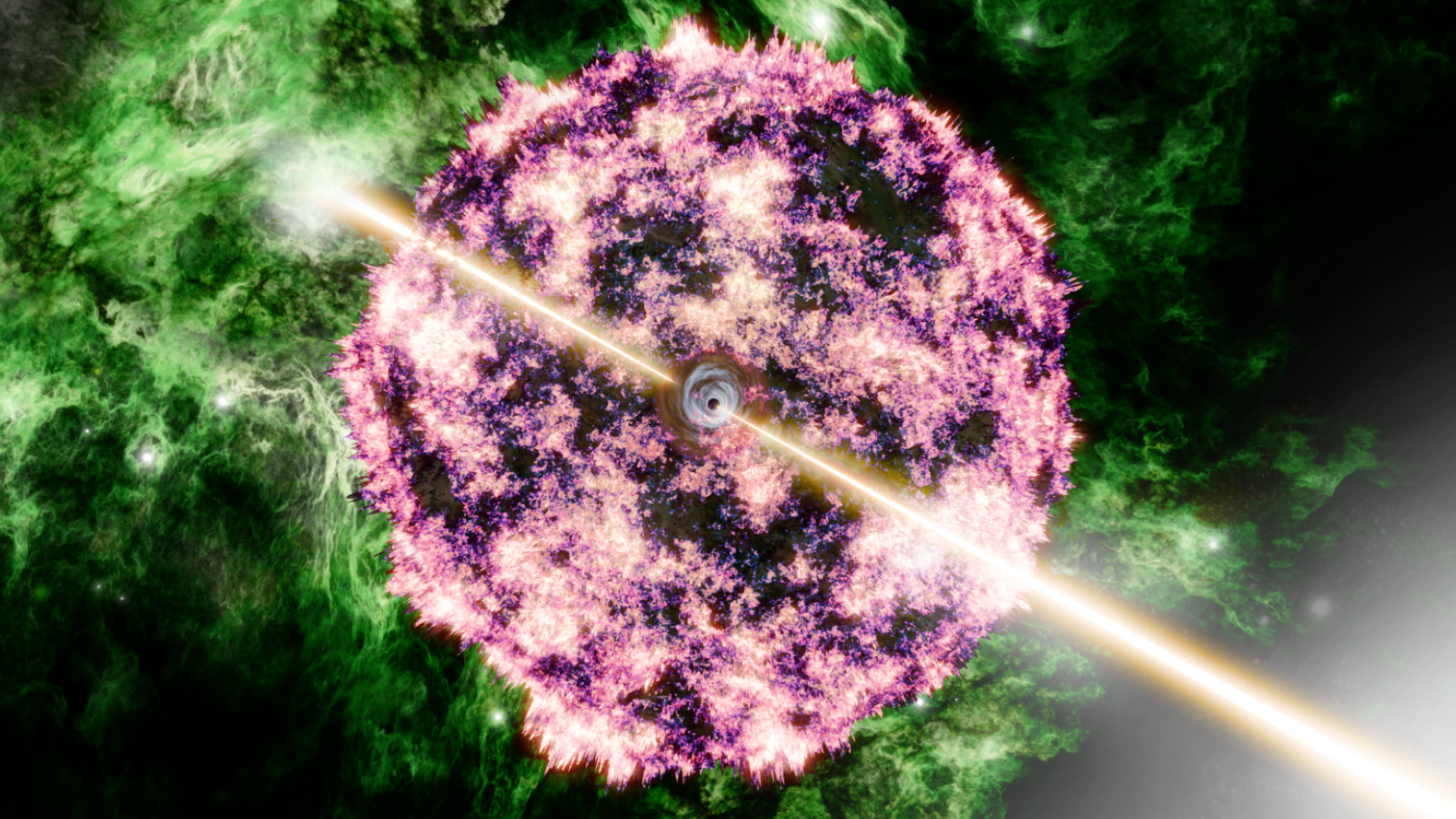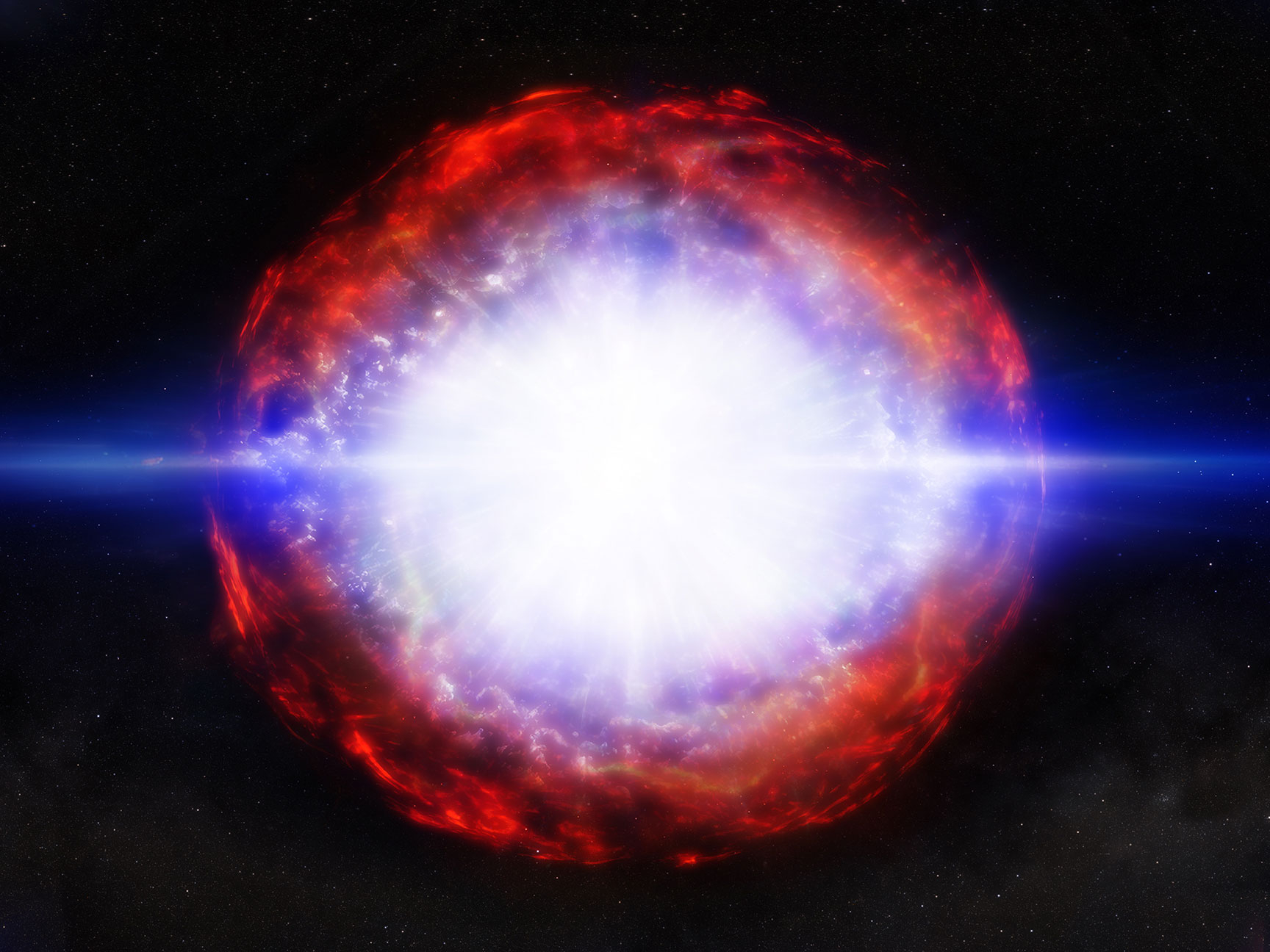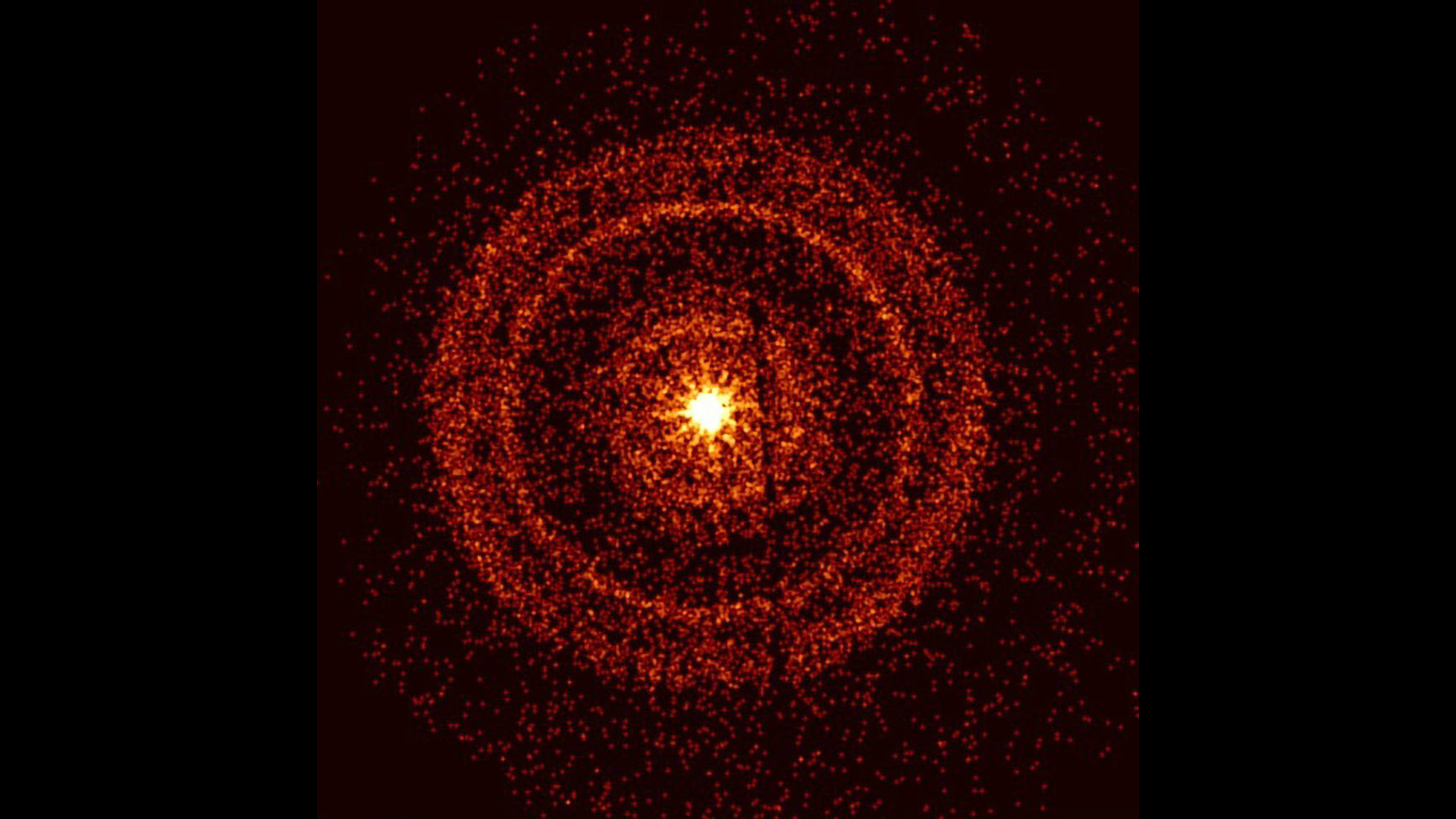Scientists identify origin of the 'BOAT' — the brightest cosmic blast of all time
"When we confirmed that the gamma-ray burst was generated by the collapse of a massive star, that gave us the opportunity to test a hypothesis for how some of the heaviest elements in the universe are formed."

Using the James Webb Space Telescope (JWST), scientists have finally solved the mysterious origins of the "BOAT," possibly the biggest cosmic explosion since the Big Bang.
The brightest gamma-ray burst of all time (hence the acronym the Brightest Of All Time), aka the BOAT, seems to have been launched by a supernova explosion that accompanied the death and collapse of a massive star located around 2.4 million light-years away. This is an event that probably also led to the birth of a black hole.
By solving this cosmic mystery, however, the team of astrophysicists has opened up yet another celestial puzzle. That's because traces of heavy elements like gold and platinum, traces one would expect to linger around this kind of supernova, are nowhere to be found.
"This was an event that Earth sees only once every 10,000 years," Peter Blanchard, team leader and a Northwestern University scientist, said in a statement. "The event produced some of the highest-energy photons ever recorded by satellites designed to detect gamma rays."
"When we confirmed that the GRB was generated by the collapse of a massive star, that gave us the opportunity to test a hypothesis for how some of the heaviest elements in the universe are formed," Blanchard added. "We did not see signatures of these heavy elements, suggesting that extremely energetic GRBs like the BOAT do not produce these elements."
Scientists didn't miss the BOAT
The BOAT, officially designated GRB 221009A, was first spotted on Oct. 9, 2022, and it immediately stood out from other GRBs due to its extreme nature. Astronomers spotted it as an immensely bright flash of high-energy gamma rays followed by a fading afterglow across many wavelengths of light.
The powerful GRB was first spotted by gamma-ray and X-ray telescopes, including NASA's Fermi Gamma-ray Space Telescope and the Neil Gehrels Swift Observatory. After the BOAT's initial detection, awestruck astronomers rushed to find its potential source. They pointed their telescopes in the direction of the constellation Sagitta, believing that's where the answer must lie.
Breaking space news, the latest updates on rocket launches, skywatching events and more!
"As long as we have been able to detect GRBs, there is no question that this GRB is the brightest we have ever witnessed by a factor of 10 or more," one of the discoverers of the BOAT Wen-fai Fong, an associate professor of physics and astronomy and leader of the Fong Group at Northwestern, had said around the time of discovery.
Blanchard and colleagues, however, didn't rush to chase the BOAT.
Instead, they wanted to view the BOAT as it evolved, and track it during its later stages. Thus, they trained the JWST on the fading gamma-ray burst around six months after it was first spotted.
"The GRB was so bright that it obscured any potential supernova signature in the first weeks and months after the burst," Blanchard said. "At these times, the so-called afterglow of the GRB was like the headlights of a car coming straight at you, preventing you from seeing the car itself.
"So, we had to wait for it to fade significantly to give us a chance of seeing the supernova."
Using the JWST's Near Infrared Spectrograph (NIRSpec) instrument, Blanchard and colleagues observed the BOAT's infrared afterglow. This revealed the signature of elements like calcium and oxygen, all of which are characteristic of supernovas.
What was surprising, however, was the even though the BOAT is the most powerful cosmic eruption of its kind ever detected, the supernova that created it actually seemed pretty average for such an explosive stellar death.
"It's not any brighter than previous supernovas. It looks fairly normal in the context of other supernovas associated with less energetic GRBs," Blanchard said. "You might expect that the same collapsing star producing a very energetic and bright GRB would also produce a very energetic and bright supernova. But it turns out that's not the case. We have this extremely luminous GRB, but a normal supernova."

The team isn't currently sure how a "normal" supernova could have created a blast of energy as massive as the BOAT.
Team member and University of Utah assistant professor of physics Tammoy Laskar thinks the extreme GRB could be a result of the shape and structure of near-light speed jets launched by collapsing massive stars as they create black holes. If a massive star is rapidly spinning when it collapses, then the beams it blasts out are narrow, then more focused, and, thus, brighter.
"It's like focusing a flashlight's beam into a narrow column, as opposed to a broad beam that washes across a whole wall," Laskar said. "In fact, this was one of the narrowest jets seen for a gamma-ray burst so far, which gives us a hint as to why the afterglow appeared as bright as it did.
"There may be other factors responsible as well, a question that researchers will be studying for years to come."
Furthermore, another aspect of this supernova that will warrant a much deeper investigation isn't something it has, but rather those things it appears to lack.
The missing elements
The hearts of stars are like stellar furnaces that fuse together light elements to create progressively heavier elements. This process forms elements right up to iron, but after that, even the most massive stars struggle to fuse heavier elements such as gold and platinum.
For many years, scientists have suspected that these relatively heavier elements are created when massively dense, dead stars called neutron stars smash together, with the JWST recently playing a key role in helping to confirm such a theory.
Yet researchers also thought the extreme environments created around supernovas capable of launching GRBs could facilitate the "rapid capture" of neutrons, or the "r-process," that forges elements like gold. The reason for this conjecture is neutron star collisions alone seem too rare to create the amounts of elements heavier than lead scientists see in the early universe.
"There is likely another source. It takes a very long time for binary neutron stars to merge. Two stars in a binary system first have to explode to leave behind neutron stars. Then, it can take billions and billions of years for the two neutron stars to slowly get closer and closer and finally merge," Blanchard said. "But observations of very old stars indicate that parts of the universe were enriched with heavy metals before most binary neutron stars would have had time to merge.
"That's pointing us to an alternative channel."
That alternative channel had been theorized to be the collapse of a rapidly spinning and massive star, the exact type of event that scientists have now confirmed launched the BOAT.
Using the JWST, the team was able to peer into the deep layers of this supernova, where elements heavier than iron should be forged. "The exploded material of the star is opaque at early times, so you can only see the outer layers," Blanchard said. "But once it expands and cools, it becomes transparent. Then, you can see the photons coming from the inner layer of the supernova. Moreover, different elements absorb and emit photons at different wavelengths, depending on their atomic structure, giving each element a unique spectral signature."
That means looking at an object's spectrum can tell astronomers what elements are present.
"Upon examining the BOAT's spectrum, we did not see any signature of heavy elements, suggesting extreme events like GRB 221009A are not primary sources," Blanchard said. "This is crucial information as we continue to try to pin down where the heaviest elements are formed."
Blanchard also says that not detecting heavy elements around the BOAT's supernova source doesn't mean scientists should give up on studying the GRB channel of heavy-element production just yet.
"That doesn’t mean that all GRBs do not produce them, but it's a key piece of information as we continue to understand where these heavy elements come from," he said. "Future observations with JWST will determine if the BOAT's 'normal' cousins produce these elements."
In addition to learning more about the BOAT and confirming its origins with the JWST, the team was also able to detect the signature of an intense bout of star formation in the event's host galaxy. This indicated the star that died to birth the BOAT may have formed in a different environment than other supernova stars.
One aspect of this galaxy that could help further unravel the secrets of the BOAT is the fact that it appears to have a low concentration of elements heavier than hydrogen or helium, which astronomers called "metals."
"This is another unique aspect of the BOAT that may help explain its properties," team member and Penn State University graduate student Yijia Li said in the statement.
"We are fortunate to live in a time when we have the technology to detect these bursts happening across the universe," Blanchard concluded. "It's so exciting to observe such a rare astronomical phenomenon as the B.O.A.T. and work to understand the physics behind this exceptional event."
The research was published on Friday (April 12) in the journal Nature Astronomy.

Robert Lea is a science journalist in the U.K. whose articles have been published in Physics World, New Scientist, Astronomy Magazine, All About Space, Newsweek and ZME Science. He also writes about science communication for Elsevier and the European Journal of Physics. Rob holds a bachelor of science degree in physics and astronomy from the U.K.’s Open University. Follow him on Twitter @sciencef1rst.



